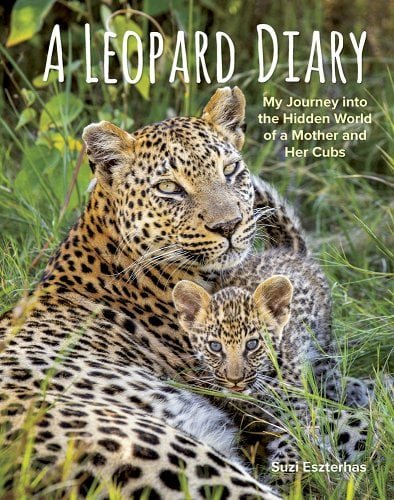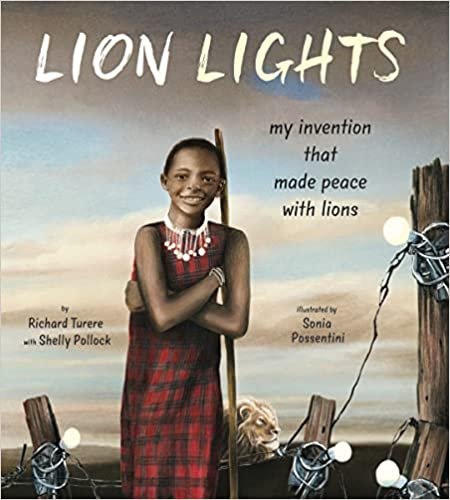An-Animal-a-Month: Big Cats
These outstanding nonfiction titles open windows into the lives of lions, leopards, and the people who live among them.
Not your average diary! Professional wildlife photographer Suzi Eszterhas specializes in photographing baby animals. When she learns of an opportunity to photograph leopard babies at a wildlife preserve in Botswana, she leaps at the chance. She shares her experiences, via close-up photographs and detailed diary entries, of witnessing two cubs grow up. Readers and listeners not only learn all about the lives of these secretive cats, but also about the patience, perseverance, and luck required to track and photograph wild animals. Suzi’s awe and appreciation for the natural world are contagious! She gives ample credit to her guide, Kambango, and ends the book with a conversation with him and information about the non-profit organization, Children in the Wilderness. An inspiring STEM read-aloud, a few diary entries per day, or a rich resource for reports on leopards. Ages 7-10.
Kind of nonfiction: Narrative – shares the true story of a mother leopard raising two cubs, preparing them for life on their own, as well as the experience of tracking and photographing these animals. (My categorization using Melissa Stewart’s 5 Kinds of Nonfiction.)
Ties to Next Generation Science Standards:
K-LS1-1 (Use observations to describe patterns of what plants and animals need to survive.) Photographs show the cubs’ need for food, beginning with their mother’s milk on page 11 and progressing to meat on page 21. The photograph on page 21 also shows their need for water. Like all animals, the cubs need protection from predators, so their mom frequently moves them from den to den. They also need to learn survival skills like hunting and marking territory, shown in photos on pages 30 and 19.
1-LS1-2 (Read texts and use media to determine patterns in the behavior of parents and offspring that help offspring survive.) Watch the mother leopard, known as Camp Female, move her cubs from den to den to keep them safe while she hunts. Page 11 shows her licking her cubs and a sidebar explains how this behavior keeps the cubs free of parasites and washes away odors that might attract predators. On pages 14-15, see the cubs developing their strength and coordination through play and hunting practice. They also learn about patrolling and marking territory, a practice that helps keep them safe from rival leopards. Towards the end of the book, watch the cubs practice spending more time on their own (like human teens), and even successfully hunting small game, as they prepare to start lives on their own.
A new kind of Maasai warrior! Richard Turere – student, inventor, Maasai warrior, and National Geographic Young Explorer – teamed up with author Shelly Pollock to write this inspiring, STEM-themed, slice-of-life autobiography. The story begins when Richard’s father chooses him to herd and protect the family’s cattle. Try as he might, he couldn’t keep the lions away from the cattle at night. Then, he noticed that the lions seemed to be afraid of his moving flashlight. This observation inspired him to invent Lion Lights, which were highly effective in preventing lion attacks. His invention not only saved the cattle but also saved the lions from being killed by the Maasai, a huge win for lion conservation. Soon, herders around the world were using Lion Lights. Readers and listeners watch as Richard perseveres despite setbacks and failures, despite the doubts of those around him. The story also illuminates Maasai culture and language and challenges in the modern world. Ages 6-11.
Kind of nonfiction: Narrative nonfiction – real characters, real setting, chronological plot, climax, and satisfying ending. (My categorization using Melissa Stewart’s 5 Kinds of Nonfiction.)
How Cecil lived! Though many people around the globe learned of Cecil’s tragic death in 2015, most don’t know about his incredible life. This well-researched and beautifully photographed book shares and celebrates Cecil’s life. Facts about how lions live and about their individuality are woven in. A powerful message about how we all need to look out for one another shines through in the end. Ages 4-8.
Kind of nonfiction: Narrative – tells the true story of one lion’s exceptional life and the meaning of his death. Back matter about lions, Cecil’s legacy, Hwange National Park, and the Oxford University Study complement the text. (My categorization using Melissa Stewart’s 5 Kinds of Nonfiction.)



